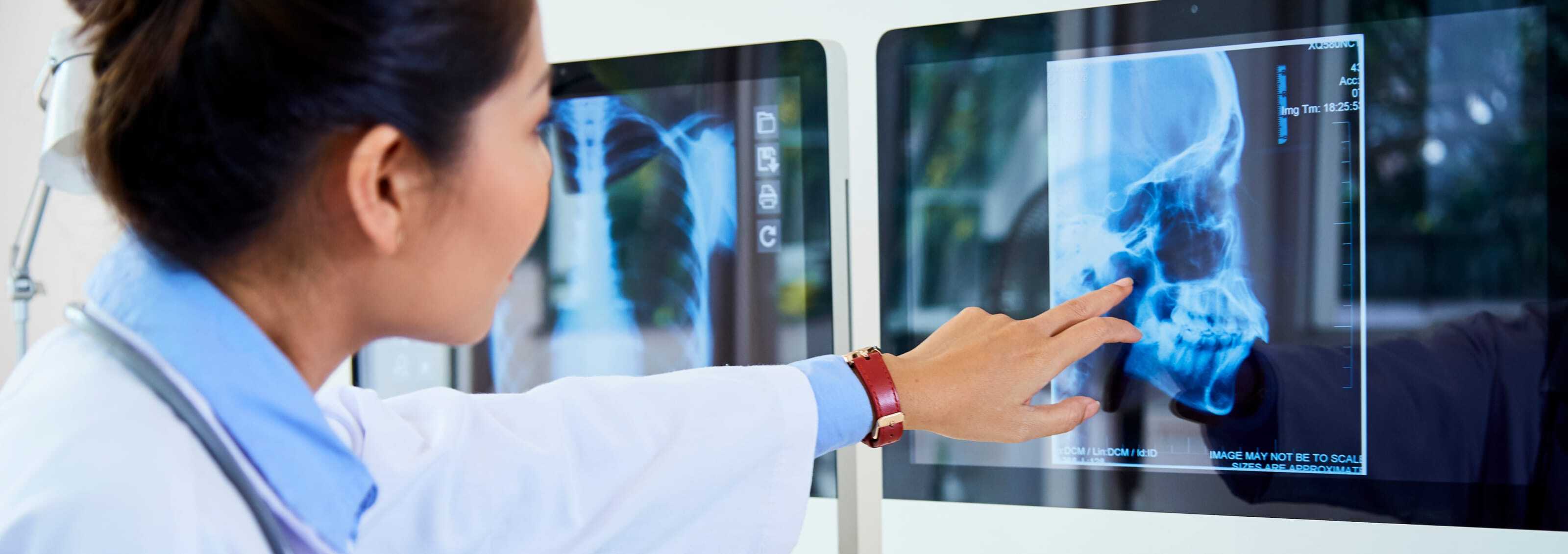
Radiologic Technology
Earn your A.A.S. degree in only two years and prepare to earn your license to work assisting with X-rays, MRIs and more.
Gain the skills needed for a rewarding career as a Radiologic Technologist! You will graduate ready to earn national certification and enter the workforce as a radiologic technologist.
On this page, find information on the Radiologic Technology program's Highlights, Certification, Radiologic Technologist Employment, Application & Aid, Outcomes, Testimonials, and Accreditation & Licensure.
- 9%
- job growth expected from 2020-2030 (BLS)
- 2
- years to complete the Radiologic Technology degree
- $95K
- mean wage in California for radiologic technologists
Highlights
Radiography is an imaging technique that uses radiation to create visual displays of the human body and internal organs. Radiologic technologists are health professionals who use radiographic techniques to create X-rays, MRIs, and other electromagnetic images that are used to help diagnose and treat patients. After nurses and physicians, radiologic technologists are one of the largest groups of health professionals in the country (ARRT).
- Our program is full-time with a lock-step curriculum.
- The program is cohort-based and has a fall start date. Including two summer semesters, it can be completed in two years.
- Our radiologic program combines world-class didactic training and hands-on clinical experience.
- You’ll learn; Diagnostic medical imaging, Equipment operation, Radiographic procedures, Patient care, and Radiation safety and protection.
- In your first semester, you'll develop a strong foundation in related scientific areas like human anatomy and physiology, as well as learn the core principles of imaging technology.
- Learn how to X-ray specific anatomical areas, how to care for patients, and learn about more complex scientific topics like radiation physics.
- Beyond coursework, students have ample opportunities to master new technical skills as they rotate through clinical sites, performing procedures under the supervision of certified technologists.
- A wide range of imaging instruments are available for student use, including simulated, non-energized laboratory equipment to help implement concepts learned in the classroom.
Certification
All students meeting the graduation requirements will be eligible to take the National Certifying Examination given by the American Registry of Radiologic Technologists (ARRT). Upon successfully completing the ARRT examination, you will also receive a California license to practice radiography in the State of California. It's necessary to have an associate’s degree to sit for the certifying exam.
Working as a Radiologic Technologist
With your associate's degree and certification, you can enter the workforce as a radiologic technologist, assisting physicians with X-rays and other imaging techniques. More than half of radiologic technologists work in hospitals. Radiologic technologists also work in other healthcare facilities, including physicians' offices and outpatient care centers.
After becoming credentialed and licensed, you can choose to jump right into full-time employment or pursue an area of specialty such as MRI, mammography, or CT, to further increase your job prospects and salary potential.
Salary & Employment Growth
According to the Bureau of Labor Statistics, the median annual wage in 2023 was approximately $76,020 for radiographers and MRI technologists nationwide. Radiographers in California earned the highest annual mean wage in the country at $95,170 per year.
The outlook for future students is even brighter. The BLS reports an expected 6% growth in employment for radiologic technologists between 2023 and 2033. California is also one of the top 5 states with the highest employment level of radiologic technologists.
Application & Aid
Program Start: Fall
Program Length: 24 Months
Admissions Requirements & Deadline: View Admissions Information
Tuition & Aid: View Tuition & Aid Information
All the information you need to apply can be found on the Radiologic Technology Admissions page.
Outcomes
Students graduating from the AAS in RT Program will be able to:
- Demonstrate appropriate technical skills in the clinical setting.
- Demonstrate effective written and oral communication.
- Demonstrate proper positioning skills.
- Exhibit proficiency in performing radiographic exams.
- Demonstrate professionalism.
Testimonials

John Ellis, MS-HA, CRT (R/F), ARRT
“A good radiographer is someone who knows radiography by the book, but a great radiographer is someone who can apply those skills to taking care of patients in a traumatic situation. Sometimes you have to think outside the box, and I can bring that to the students here, so they can better deal with trauma in the ER.”
Accreditation & Licensure
The Touro University California Rad Tech Program is accredited by both WASC and CDPH-RHB (California Department of Public Health-Radiation Health Branch). Our standards for the program come directly from the American Registry of Radiologic Technologists (ARRT), the Joint Review Committee on Education in Educational Programs in Radiologic Technology (JRCERT), and the American Society of Radiologic Technologists (ASRT). Graduates of our program are fully eligible to take their ARRT / CDPH-RHB Registry Examinations. Once they pass, they will be certified to practice in the field.
